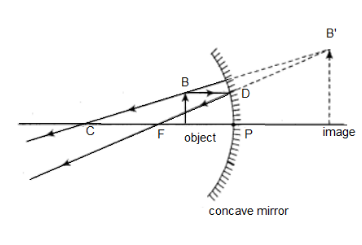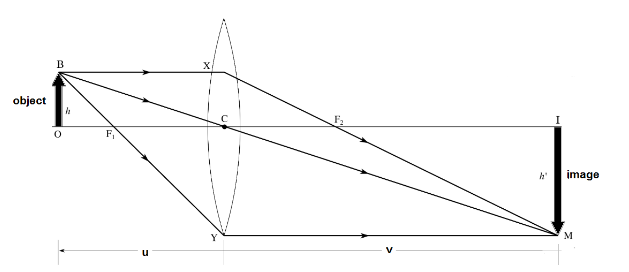
To construct a ray diagram, we use two light rays which are so chosen that it is easy to know their directions after reflection from the lens. List the two rays and state the path of these rays after refraction. Use these two rays to locate the image of an object placed between and of convex lens.
Answer
525k+ views
Hint: In order to solve this question, we are going to first construct the ray diagram for the formation of image of an object placed between the pole and the focus of the mirror and list the two type of rays that are formed after refraction.
Complete step by step solution:
Let us first construct the ray diagram for an object lying in front of the concave mirror and the corresponding image formation.

The two types of rays that we need to list here in the question are:
i) The ray of light that is parallel to the principal axis, it passes through the point $ F $ of the concave mirror after its reflection.
Ii) The ray of light passing through the point $ C $ of the mirror, is reflected back on the same path after reflection from the mirror.
In the ray diagram below, as we can see that the object is placed in between the points and of the convex lens. In this case, the image is formed beyond the lens, is greater than the size of the image and is formed behind the $ 2F $ .

Note:
It is important to note that the convex lens and the concave mirror show a similar behavior in many cases, like those including the formation of a real or a virtual image. But specific cases of different objects placed at the different points for the convex lens and the concave mirror are completely different.
Complete step by step solution:
Let us first construct the ray diagram for an object lying in front of the concave mirror and the corresponding image formation.

The two types of rays that we need to list here in the question are:
i) The ray of light that is parallel to the principal axis, it passes through the point $ F $ of the concave mirror after its reflection.
Ii) The ray of light passing through the point $ C $ of the mirror, is reflected back on the same path after reflection from the mirror.
In the ray diagram below, as we can see that the object is placed in between the points and of the convex lens. In this case, the image is formed beyond the lens, is greater than the size of the image and is formed behind the $ 2F $ .

Note:
It is important to note that the convex lens and the concave mirror show a similar behavior in many cases, like those including the formation of a real or a virtual image. But specific cases of different objects placed at the different points for the convex lens and the concave mirror are completely different.
Recently Updated Pages
A man running at a speed 5 ms is viewed in the side class 12 physics CBSE

The number of solutions in x in 02pi for which sqrt class 12 maths CBSE

State and explain Hardy Weinbergs Principle class 12 biology CBSE

Write any two methods of preparation of phenol Give class 12 chemistry CBSE

Which of the following statements is wrong a Amnion class 12 biology CBSE

Differentiate between action potential and resting class 12 biology CBSE

Trending doubts
What are the major means of transport Explain each class 12 social science CBSE

Which are the Top 10 Largest Countries of the World?

Draw a labelled sketch of the human eye class 12 physics CBSE

How much time does it take to bleed after eating p class 12 biology CBSE

Explain sex determination in humans with line diag class 12 biology CBSE

Explain sex determination in humans with the help of class 12 biology CBSE




